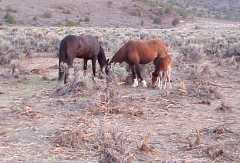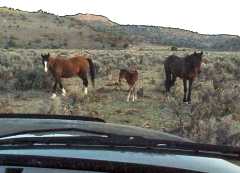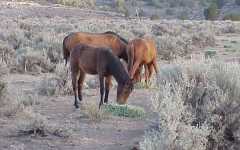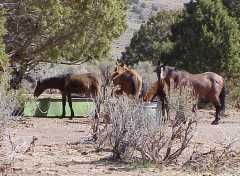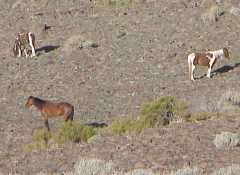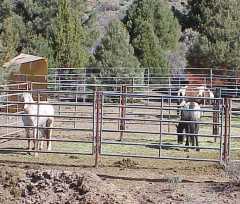
|
Least Resistance Training Concepts
Adoption Crisis in Nevada |
Drought and wildfires have denuded
|
|
DROUGHT!
It's the worst drought since the great depression. In some locations the lack of rainfall is the worst ever recorded. No rainfall means a pitiful grass crop and the failure of springs and small streams. It is not just the horses that are impacted. All the wildlife is suffering. Ranchers are similarly impacted, having to remove livestock from a number of areas or supplement them with hay. Wild horses are survivors. In hard times they can outcompete many native species and range managers have to maintain as best they can a healthy balance of range ecology. 100 years ago the horses would have migrated to the lower elevations but most of those regions are now filled with people, houses, cars and highways. Still horses are roaming down into populated areas in their desperate search for enough food and water... with devastating results. Highway accidents involving wild horses are becoming common occurrences. People who don't appreciate wild horses wandering into their areas are shooting them. On the first weekend of November a black stallion was shot in Minden and his ears cut off. State approved emergency feeding and watering programs have allowed a number of horses to remain in the upper elevations however these activities can only address a portion of the problem. |
A family band waiting for an emergency feed drop
|
|
This problem must be dealt with and it is a long term problem. If normal weather resumes it will still take years for some of the rangelands to recover. While emergency trapping of "problem horses" will undoubtedly continue, the hard fact is that additional horses will have to come off the range. The immediate issue involves those horses that have wandered down into urbanized areas. In their search for food and water many have become desensitized to humans. They no longer exhibit true wild horse behavior and they become regular nuisances and traffic hazards. Most of the horses currently being trapped fit into this category. A more delicate issue is that the ongoing drought has forced everyone to reconsider how many horses the range can sustain and still return to healthy conditions. Healthy ranges equal healthy horses as well as healthy wildlife of all types. While there will likely be great debate over the appropriate number of horses that should roam the Virginia Range, there is little doubt that the herd will have to be reduced to some extent. So the horses keep on coming into the state holding facility where they desperately need competent adopters. |
A landscape barren of grass
|
|
It's no secret. A number of states are experiencing significant budget shortfalls. Nevada is no exception. To describe the current funding of the Nevada wild horse program as bare bones would be optimistic. The participation of non-profit wild horse groups in the adoption process is essential for the protection of those horses in the state holding facility... and for those additional horses that will surely be brought in. People willing to adopt and people willing to help support the adopter groups through volunteering their time and/or making donations will give everyone who is working hard for these animals a chance of being successful. If you are interested in wild horses, here is a serious issue where you can get involved and make a difference! |
Horses being held for adoption
|
How You can help!Photo Collage - The Horses Before the DroughtReturn to "Adopt a Comstock Wild Horse" PageReturn to Lucky Horse ProjectProject Scrap BookVisit the "Wild Horse Help Desk"Return to LRTC Home PageLeast Resistance Training Concepts is a 501(c)(3) non-profit educational corporation based in Knightsen, California, with volunteers in thirty one states. | |
